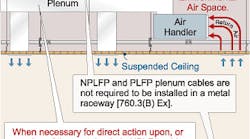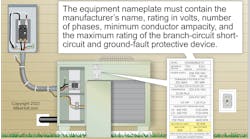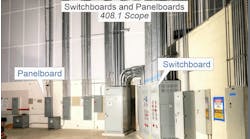Article 760 tells us how to install wiring and equipment for fire alarm systems, including all circuits these devices control and provide power to. What it doesn't tell us is when a fire alarm system is required to be installed in the first place — or where to place the alarm equipment, such as pull stations or horn/strobe units. For installation information, consult the locally adopted building code or NFPA 101, Life Safety Code. For placement of such equipment, turn to NFPA 72, National Fire Alarm Code.
As defined in NFPA 72, residential smoke alarm systems (including interconnecting wiring) are not powered by a fire alarm system. Therefore, Art. 760 does not cover them. Fire alarm systems include fire detection and alarm notification, voice communications, guard's tour, sprinkler water flow, and sprinkler supervisory systems [760.1 FPN 1].
Chapter 3 in reverse. When applying most Articles in Chapters 5 through 8, Chapter 3 wiring methods apply — except as noted. When applying Art. 760, Chapter 3 wiring methods do not apply, except as noted. You'll find the Chapter 3 references, as well as some other Article references, in 760.3.
One of the requirements is, naturally, that of firestopping. Openings in fire-resistant walls, floors, and ceilings must be sealed to minimize the possible spread of fire or products of combustion [300.21].
This requirement logically leads into the requirement to remove abandoned cable. Doing so limits the accumulation of products of combustion within a building. You must remove the accessible portion of fire alarm cable that isn't terminated at equipment and not identified for future use with a tag [760.2]. This rule doesn't require the removal of concealed cables that are abandoned in place. Cables in raceways are concealed cables, per the definition of “concealed” in Art. 100.
Some Chapter 3 wiring methods apply conditionally. For example, suppose you want to install fire alarm cables in ducts or plenums. If this is necessary for the direct action upon (or sensing of) the contained air, such as for a smoke detector inside of an air duct, you can do it, but only if you install those cables in electrical metallic tubing, intermediate metal conduit, or rigid metal conduit per 300.22(B) (Fig. 1).
You can install plenum-rated fire alarm cables above a suspended ceiling or below a raised floor used for environmental air movement [760.30(B)(1) and (2), 760.61(A), and 760.82(A)]. You can also install nonplenum-rated fire alarm cables above a suspended ceiling or below a raised floor used for environmental air, but only if you install the cable within electrical metallic tubing or one of the other raceways identified in 300.22(C)(1). Nonplenum-rated fire alarm cables are, of course, allowed above a suspended ceiling that is not used for environmental air.
Fire alarm cables installed beneath a raised floor in an information technology (IT) equipment room aren't required to be plenum rated [300.22(D) and 645.5(D)(5)(c)].
The power source for a fire alarm circuit must not be supplied through a GFCI or an AFCI [760.21]. But this limitation applies only to the circuit that supplies a power-limited fire alarm system (PLFA) or a nonpower-limited fire alarm system (NPLFA). This rule is not intended to apply to the single station smoke alarms commonly found in a dwelling unit. Once again, Art. 760 does not cover these types of devices.
Fig. 2.Labeling is required for fire alarm circuits at all terminal and junction locations.
Access and execution. As with many other Articles, Art. 760 requires you to install equipment and cabling in a neat and workmanlike manner [760.8]. Although the NEC doesn't define this, qualified workers know the difference between sloppy and neat work. Article 760 also provides a few hints as to what the AHJ will expect. For example, one aspect of “sloppy” is allowing ceiling-routed cables to accumulate in a way that prevents moving the ceiling panels so a person can get to them [760.7].
Article 760 also tells us that one aspect of good workmanship is supporting the cables by the structural components of the building so the cable won't be damaged by normal building use. Secure those cables with the right hardware, and take care not to pinch or damage the cable when you do.
Common sense says you haven't done quality work unless you have properly labeled the circuits at terminal and junction locations. This labeling is a requirement for fire alarm circuits [760.10] (Fig. 2). But, contrary to some manufacturers' statements, Art. 760 does not require you to mark raceways and cables [760.42].
Where Art. 760 is silent on other aspects of good workmanship, don't read something that's not there. To avoid being forced to rewire or reinstall, don't ignore the generally accepted workmanship practices.
Circuit types. A fire alarm system circuit can be one of two types: NPLFA or PLFA. What's the difference between the two?
- An NPLFA can operate at up to 600V, and the power output isn't limited [760.21].
- A PLFA has the voltage and power limited by a listed power source that complies with 760.41.
This difference means easier installation requirements for PLFA circuits, but these two types of circuits share all of the requirements detailed in Part I.
NPLFA. To meet NPLFA requirements, you'll need to refer to Chapter 3 and use those wiring methods where specified. Here are some highlights.
Overcurrent protection. For conductors 14 AWG and larger, this must be limited to the conductor ampacity per Table 310.16 and 240.6(A). Overcurrent protection can't exceed 7A for 18 AWG conductors, or 10A for 16 AWG conductors [760.23].
Wiring methods. NPLFA circuits must be installed using Chapter 3 wiring methods, and all splices must be in enclosures [300.15], except for splices and terminations in fire alarm devices and utilization equipment (e.g., detectors) [760.30(A)(1)]. This rule does not apply to multiconductor NPLFA cables for circuits operating at 150V or less [760.30].
Conductor size. Only copper conductors can be used for fire alarm systems. You can use conductors of sizes 18 AWG and 16 AWG (installed in a raceway, enclosure, or listed cable) if they do not supply a load that exceeds the ampacities given in 402.5. Conductors larger than 16 AWG must not supply loads greater than the ampacities given in 310.15 [760.27(A)].
Conductor insulation. Use conductors with a 600V insulation rating, and comply with Art. 310. For conductors 18 AWG and 16 AWG, comply with 760.27(B). Table 402.3 provides application provisions [760.27(B) FPN].
Number of conductors in a raceway. Comply with the fill requirements of 300.17 [760.25].
PLFA. PLFA requirements, found in Part III of Art. 760, apply to the load side of the circuit. For supply side wiring and equipment, use Part II (NPLFA), as well as the general installation rules in Chapters 1 through 4 [760.51].
Fig. 3. Splices and terminations of power-limited fire alarm circuits must be made in listed fittings, boxes, enclosures, fire alarm devices, or utilization equipment.
Wiring methods. You can use NPLFA wiring methods and materials [760.52(A)], if you choose, instead of PLFA. The PLFA wiring requirements are minimal 760.52(B)]. You can sum them up this way: Put cable splices or terminations in listed fittings, boxes, etc., and ensure exposed cables are adequately supported (Fig. 3).
Separation from power conductors. Provide a minimum of 2 inches of separation between PLFA conductors and conductors of electric light, power, Class 1, or NPLFA circuits, unless you meet the requirements of 760.55(G) (Fig. 4). Don't put PLFA conductors in any enclosure, raceway, or cable with conductors of electric light, power, Class 1, or NPLFA circuit conductors, except when you:
- Provide barriers.
- Meet the requirements outlined in 760.55(D), one of which is that these conductors are present solely for connection to the same equipment.
Fig. 4. Provide a minimum of 2 inches of separation between PLFA conductors and conductors of electric light, power, Class 1, or NPLFA circuits, unless you meet the requirements of 760.55(G).
Class 2, Class 3, and communications circuits. Class 3 and communications circuits can be in the same cable, enclosure, or raceway as PLFA circuits [760.56(A)]. Class 2 circuits can be in the same cable, enclosure, or raceway as PLFA circuits — if the Class 2 circuit conductor insulation isn't less than that required for the PLFA circuits [760.56(B), 760.82(C)].
You can't install audio system circuits [760.56(D), 640.9(C)] (using Class 2 or Class 3 wiring methods) in the same cable or raceway with PLFA conductors or cables.
Listing. Part IV of Art. 760 details the listing requirements. This information is primarily for manufacturers. What does this mean for you? Use the cables listed for the application.
The NEC doesn't require outside or underground cable to be listed, but the cable must be approved by the AHJ as suitable for the application per 90.4, 90.7, and 110.2.
Give special consideration to cables in areas that move or transport environmental air, so as to reduce the hazards that arise from the burning of conductor insulation and cable jackets. Because listed plenum-rated cables have adequate fire-resistance and low smoke-producing characteristics, you can use them in environmental air space. But you can't use them in ducts or plenums.
Before deciding how to install fire system equipment or wiring, turn to Art. 760. Apply the requirements of Part I, regardless of the power level. Apply the requirements of Part II to the supply side and to load side wiring and equipment of NPLFA. Don't apply Part III requirements unless the power source for the circuit is a Class 3 transformer or power supply, or it's a listed PLFA power source [760.41].
If you find it more economical to apply Part II requirements in place of Part III requirements, Art. 760 allows you to do so. Review a line drawing of the circuits involved, before making this determination.




